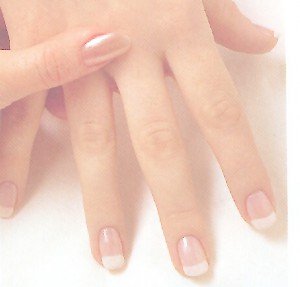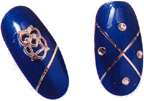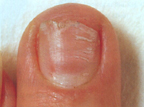Faking it
Contents

Okay, you hate to admit it, but sometimes you’re just a one-night-stand kind of girl. Easy come, easy go – at least as far as your nails are concerned. Sometimes you’re looking for a longer-term relationship with your nails – say a week or so. But going it alone with just your home-grown assets (no, your nails, silly) may just not work out the way you’d hoped.
And sometimes you just need to indulge that whim, that adventurous, creative streak, and do something totally outlandish and fun with your nails.
Fear not; there are all kinds of artificial nails to get you through all kinds of situations, and all kinds of neat special effects and tricks you can do.
Press-Ons: the One Night Stand
These are plastic nails that stick onto your regular nails to give length, shape and smoothness. You can get them with peel ‘n’ stick adhesive; the better ones come with a small tube of very strong glue. You may find them easier to remove if you get a small tube of contact cement and use that instead.
When buying press-ons, make sure they’re large enough. You can often get different sizes; pay special attention to thumbnails.
Use care when applying these. You don’t get to reposition them once they’re stuck, so make sure you place them accurately.
 To apply the glued-on variety:
To apply the glued-on variety:
- Shape the tip of your existing nail to match the recess in the bottom of the artificial one.
- Apply a tiny bead of glue to the artificial nail where the tip of your real nail will land.
- Tilt the artificial nail down (away from the back of your hand) as you place it on your nail, then tilt it up to force the glue out evenly towards the base of your nail. Done correctly, and with the proper amount of glue, there should be no bubbles and a minimum of excess glue to wipe off.
Once they’re on, you can shape them with an ordinary nail file, then polish them as described previously. The advantage is that you don’t need base coat since staining is not a worry.
Tip: buy a practice set and wear them around the house for a day to get accustomed to them and learn what kinds of stress you can put them through without them falling off.
Tip: keep your nail glue or contact cement in your purse for emergency reattachments.
Press-ons are fairly easy to remove; see Cleanup for how to do it.
The Weekender: Gel Nails
Gel nails are basically plastic tips glued onto your regular nails. A special gel compound is brushed onto the nail to build up the space between the tip and the base of the nail. Properly applied, they look very real and are quite durable. They can be made to almost any length you desire. They take polish well. Since you’ll probably be wearing them for a while, make sure you use base coat to prevent staining.
You can do gel nails yourself, but it’s worth spending the money to get them done right at least once, if only for the learning experience.
See Cleanup for how to remove them.
Weekend in Paris: The French Manicure
More a style of polish than an actual manicure procedure, the French manicure is distinguished by natural-coloured nails and strikingly white tips. A top coat smooths out any irregularities. You can do it yourself with white and clear nail polishes. A steady hand is important to get the “smile line” at the base of the white tip perfectly even and straight. You can buy French manicure kits that include a plastic guide to help with this.
French manicures can be applied to natural nails or artificial ones.
Long-Term: Acrylic Nails
Acrylics are very durable, hard nails that will easily last from a week to a month. Like gels, they begin with a thin plastic tip glued to your regular nail, then trimmed and shaped. Your nails are roughened and filed to provide a good bonding surface. Acrylic powder and a solvent are then mixed and brushed onto your nail and the tip to create a smooth, hard nail that’s bonded to your natural nail.
Acrylic nails are best applied by a professional in a salon. You can buy kits, but be prepared to practise.
Acrylics take polish or almost any effect well. The comments above regarding base coat apply equally here.
As your nails grow out, the space behind the acrylic must periodically be filled to maintain the smooth surface; this is what’s known as a “nail fill”.
Acrylics are quite invasive and can be hard on your nails if worn for long periods of time. Don’t plan on wearing them for more than a few weeks without giving your nails a chance to breathe and regrow properly.
Removing acrylics is not difficult but it takes time. See Cleanup for instructions.

